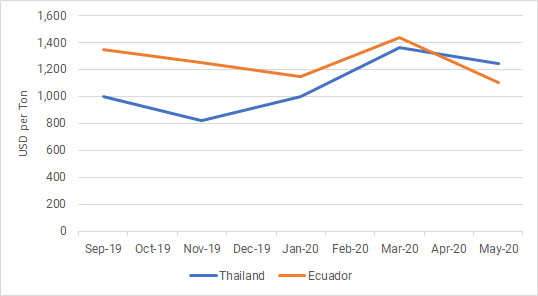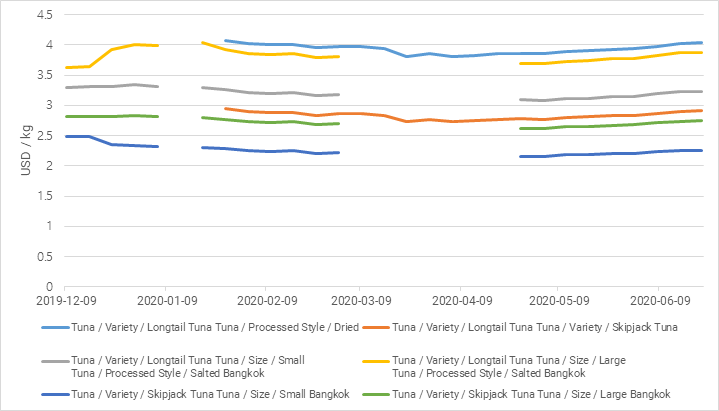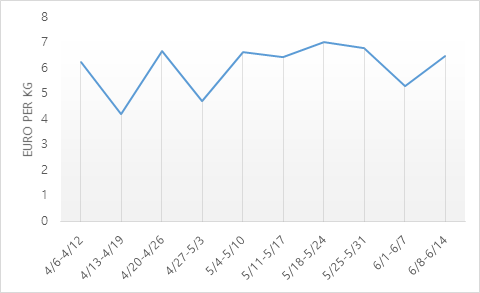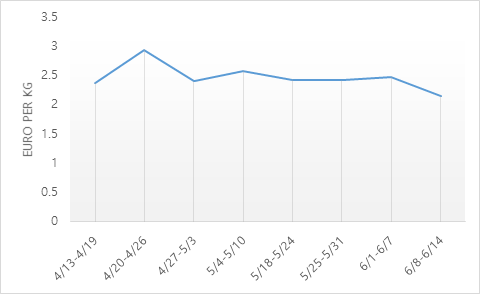Global Market Trends: Tuna
Global Supply & Demand trend of Tuna (Yellowfin & Skipjack)
Over the years, more and more vessels have come into the tuna industry. Catches have been generally moving upwards, but consumption in some major markets like the United States has been static or even declining. In addition, food manufacturers need far less tuna today to produce the so-called standard case than they did a decade ago. There is a tendency to put less tuna in the can by reducing can sizes and by adding other items, such as vegetables.
Price Trends
However, within the short-term trends, the price is on a rollercoaster ride. The drop in demand in foodservice, caused by the coronavirus pandemic, put pressure on the price on downwards but now it seems slower fishing is causing the prices to increase again. Prices for yellowfin tuna are on the rise again, after diving €500-€550 per metric ton to around €1,800/t earlier in June.
The wholesale price of salted skipjack tuna in Thailand has remained in a stable position since May but has been slowly increasing up until $4.04 per kg in Bangkok. The ex-vessel price of Skipjack tuna peaked in March, and slowly decreased until May.
Graph 1. Ex-Vessel Prices of Skipjack Tuna (Thailand, Ecuador)

Graph 2. Wholesale Prices of Tuna (Salted - Longtail, Skipjack) in Thailand

Graph 3. Prices of Yellowfish Tuna Imports to the EU from Ecuador (loins preserved or prepared)

Graph 4. Prices of Yellowfish Tuna Imports to the EU from the Philippines (frozen, for industrial use)

Export Trends
Vietnam
By the end of May, tuna export value from Vietnam reached nearly US $ 241 million, down nearly 20% over the same period in 2019. Vietnam's exports were difficult to recover because COVID-19 in many big markets is still complicated. The top ten markets of Vietnam's tuna importers all decreased in value.
Although the export value for Vietnamese tuna has greatly reduced, Vietnam is expecting a large boost in their exports to the EU, under the Free Trade Agreement that will come in effect in August. There will be annual quotas for products including canned tuna and canned fish balls while taxes on fresh and frozen tuna, except for frozen tuna (HS0304) will be eliminated. This will potentially elevate the Vietnamese tuna market against other large players such as China and Thailand.
Thailand
The tuna industry in Thailand has to import around 90% of its raw material for Skipjack tuna, and the canned tuna industry has suffered from fluctuating market prices since May. Tuna prices in Thailand normally increase during July and September, because Western Central Pacific Fisheries Commission sets a rule to control tuna fishing in the Pacific Ocean.
Ecuador
Ecuadorian prepared tuna exports to the EU were up by a quarter in Q1: total volume reached 42,000 tonnes, of which 30% is precooked tuna loins. The average FOB price customs data for the period is 13% down year on year.
Sources